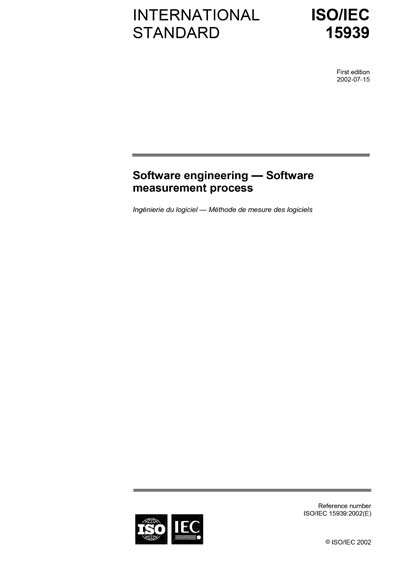Historical
ISO/IEC 15939:2002
Software engineering - Software measurement process
Purpose
This International Standard identifies the activities and tasks that are necessary to successfully identify, define, select, apply, and improve software measurement within an overall project or organisational measurement structure. It also provides definitions for measurement terms commonly used within the software industry.
This International Standard does not catalogue software measures, nor does it provide a recommended set of measures to apply on software projects. It does identify a process that supports defining a suitable set of measures that address specific information needs.
Field of application
This International Standard is intended to be used by software suppliers and acquirers. Software suppliers include personnel performing management, technical, and quality management functions in software development, maintenance, integration, and product support organisations. Software acquirers include personnel performing management, technical, and quality management functions in software procurement and user organisations.
The following are examples of how this International Standard can be used:
- By a supplier to implement a software measurement process to address specific project or organisational information requirements.
- By an acquirer (or third-party agents) for evaluating conformance of the supplier's software measurement process to this International Standard.
- By an acquirer (or third-party agents) to implement a software measurement process to address specific technical and project management information requirements related to the acquisition.
- In a contract between an acquirer and a supplier as a method for defining the software process and product measurement information to be exchanged.
Tailoring this International Standard
This International Standard contains a set of activities and tasks that comprise a software measurement process that meets the specific needs of software organisations and projects. The tailoring process consists of modifying the non-normative descriptions of the tasks to achieve the purpose and outcomes of the software measurement process. All normative clauses shall be satisfied. New activities and tasks not defined in this International Standard may be added as part of tailoring.
Conformance
Conformance to this International Standard is defined as satisfying the purpose and outcomes of the measurement process and all of the normative clauses within the tasks in Clause 5. Any organisation imposing this International Standard as a condition of trade is responsible for specifying and making public all task-specific criteria to be imposed in conjunction with this International Standard.
Throughout this International Standard, “shall” is used to express a provision that is binding on the party that is applying this International Standard, “should” to express a recommendation among other possibilities, and “may” to indicate a course of action permissible within the limits of the International Standard.
It is the responsibility of the organisation to maintain appropriate evidence of satisfaction of the normative clauses for purposes of demonstrating conformance.
Limitations
This International Standard does not assume or prescribe an organisational model for measurement. The user of this International Standard should decide, for example, whether a separate measurement function is necessary within the organisation, whether the measurement function should be integrated within individual software projects, or across projects, based on the current organisational structure, culture, and prevailing constraints.
This International Standard is not intended to prescribe the name, format, or explicit content of the documentation to be produced. The International Standard does not imply that documents be packaged, or combined in some fashion. These decisions are left to the user of the International Standard.
The measurement process should be appropriately integrated with the organisational quality system. Not all aspects of internal audits and non-compliance reporting are covered explicitly in this International Standard, as they are assumed to be in the domain of the quality system.
This International Standard is not intended to conflict with any organisational policies, standards, or procedures that are already in place. However, any conflict should be resolved and any overriding conditions and situations need to be cited in writing as exceptions to the application of the International Standard.
International Organization for Standardization [iso]


